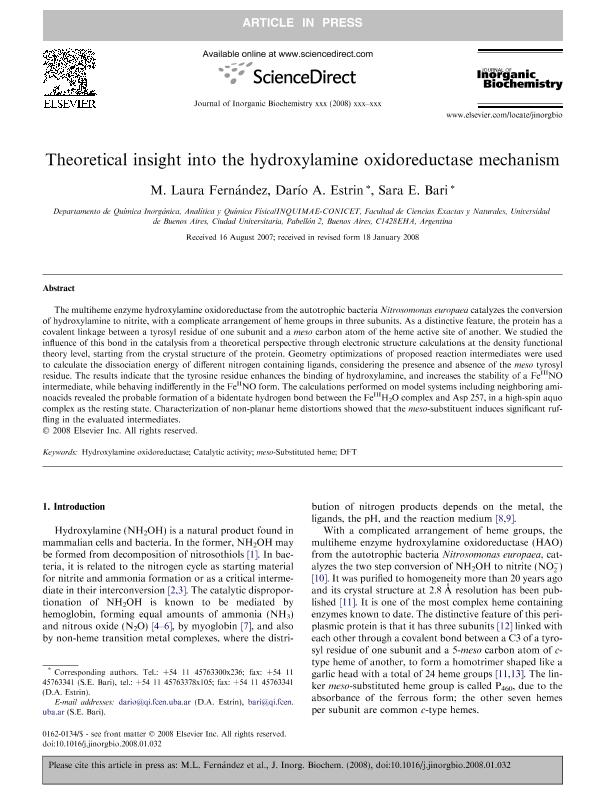Mostrar el registro sencillo del ítem
dc.contributor.author
Fernández, María Laura

dc.contributor.author
Estrin, Dario Ariel

dc.contributor.author
Bari, Sara Elizabeth

dc.date.available
2019-04-08T20:06:09Z
dc.date.issued
2008-07
dc.identifier.citation
Fernández, María Laura; Estrin, Dario Ariel; Bari, Sara Elizabeth; Theoretical insight into the hydroxylamine oxidoreductase mechanism; Elsevier Science Inc; Journal of Inorganic Biochemistry; 102; 7; 7-2008; 1523-1530
dc.identifier.issn
0162-0134
dc.identifier.uri
http://hdl.handle.net/11336/73487
dc.description.abstract
The multiheme enzyme hydroxylamine oxidoreductase from the autotrophic bacteria Nitrosomonas europaea catalyzes the conversion of hydroxylamine to nitrite, with a complicate arrangement of heme groups in three subunits. As a distinctive feature, the protein has a covalent linkage between a tyrosyl residue of one subunit and a meso carbon atom of the heme active site of another. We studied the influence of this bond in the catalysis from a theoretical perspective through electronic structure calculations at the density functional theory level, starting from the crystal structure of the protein. Geometry optimizations of proposed reaction intermediates were used to calculate the dissociation energy of different nitrogen containing ligands, considering the presence and absence of the meso tyrosyl residue. The results indicate that the tyrosine residue enhances the binding of hydroxylamine, and increases the stability of a Fe III NO intermediate, while behaving indifferently in the Fe II NO form. The calculations performed on model systems including neighboring aminoacids revealed the probable formation of a bidentate hydrogen bond between the Fe III H 2 O complex and Asp 257, in a high-spin aquo complex as the resting state. Characterization of non-planar heme distortions showed that the meso-substituent induces significant ruffling in the evaluated intermediates.
dc.format
application/pdf
dc.language.iso
eng
dc.publisher
Elsevier Science Inc

dc.rights
info:eu-repo/semantics/openAccess
dc.rights.uri
https://creativecommons.org/licenses/by-nc-nd/2.5/ar/
dc.subject
Catalytic Activity
dc.subject
Dft
dc.subject
Hydroxylamine Oxidoreductase
dc.subject
Meso-Substituted Heme
dc.subject.classification
Otras Ciencias Químicas

dc.subject.classification
Ciencias Químicas

dc.subject.classification
CIENCIAS NATURALES Y EXACTAS

dc.title
Theoretical insight into the hydroxylamine oxidoreductase mechanism
dc.type
info:eu-repo/semantics/article
dc.type
info:ar-repo/semantics/artículo
dc.type
info:eu-repo/semantics/publishedVersion
dc.date.updated
2019-03-27T18:04:07Z
dc.journal.volume
102
dc.journal.number
7
dc.journal.pagination
1523-1530
dc.journal.pais
Estados Unidos

dc.description.fil
Fil: Fernández, María Laura. Consejo Nacional de Investigaciones Científicas y Técnicas. Oficina de Coordinación Administrativa Ciudad Universitaria. Instituto de Química, Física de los Materiales, Medioambiente y Energía. Universidad de Buenos Aires. Facultad de Ciencias Exactas y Naturales. Instituto de Química, Física de los Materiales, Medioambiente y Energía; Argentina
dc.description.fil
Fil: Estrin, Dario Ariel. Consejo Nacional de Investigaciones Científicas y Técnicas. Oficina de Coordinación Administrativa Ciudad Universitaria. Instituto de Química, Física de los Materiales, Medioambiente y Energía. Universidad de Buenos Aires. Facultad de Ciencias Exactas y Naturales. Instituto de Química, Física de los Materiales, Medioambiente y Energía; Argentina
dc.description.fil
Fil: Bari, Sara Elizabeth. Consejo Nacional de Investigaciones Científicas y Técnicas. Oficina de Coordinación Administrativa Ciudad Universitaria. Instituto de Química, Física de los Materiales, Medioambiente y Energía. Universidad de Buenos Aires. Facultad de Ciencias Exactas y Naturales. Instituto de Química, Física de los Materiales, Medioambiente y Energía; Argentina
dc.journal.title
Journal of Inorganic Biochemistry

dc.relation.alternativeid
info:eu-repo/semantics/altIdentifier/doi/http://dx.doi.org/10.1016/j.jinorgbio.2008.01.032
dc.relation.alternativeid
info:eu-repo/semantics/altIdentifier/url/https://www.sciencedirect.com/science/article/pii/S0162013408000603
Archivos asociados
